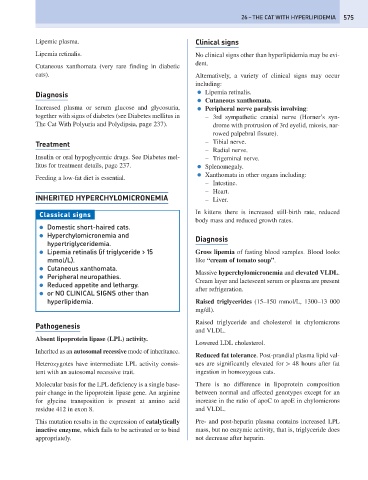Page 583 - Problem-Based Feline Medicine
P. 583
26 – THE CAT WITH HYPERLIPIDEMIA 575
Lipemic plasma. Clinical signs
Lipemia retinalis. No clinical signs other than hyperlipidemia may be evi-
dent.
Cutaneous xanthomata (very rare finding in diabetic
cats). Alternatively, a variety of clinical signs may occur
including:
Diagnosis ● Lipemia retinalis.
● Cutaneous xanthomata.
Increased plasma or serum glucose and glycosuria, ● Peripheral nerve paralysis involving:
together with signs of diabetes (see Diabetes mellitus in – 3rd sympathetic cranial nerve (Horner’s syn-
The Cat With Polyuria and Polydipsia, page 237). drome with protrusion of 3rd eyelid, miosis, nar-
rowed palpebral fissure).
Treatment – Tibial nerve.
– Radial nerve.
Insulin or oral hypoglycemic drugs. See Diabetes mel- – Trigeminal nerve.
litus for treatment details, page 237. ● Splenomegaly.
● Xanthomata in other organs including:
Feeding a low-fat diet is essential.
– Intestine.
– Heart.
INHERITED HYPERCHYLOMICRONEMIA –Liver.
In kittens there is increased still-birth rate, reduced
Classical signs
body mass and reduced growth rates.
● Domestic short-haired cats.
● Hyperchylomicronemia and Diagnosis
hypertriglyceridemia.
● Lipemia retinalis (if triglyceride > 15 Gross lipemia of fasting blood samples. Blood looks
mmol/L). like “cream of tomato soup”.
● Cutaneous xanthomata.
Massive hyperchylomicronemia and elevated VLDL.
● Peripheral neuropathies.
Cream layer and lactescent serum or plasma are present
● Reduced appetite and lethargy.
after refrigeration.
● or NO CLINICAL SIGNS other than
hyperlipidemia. Raised triglycerides (15–150 mmol/L, 1300–13 000
mg/dl).
Raised triglyceride and cholesterol in chylomicrons
Pathogenesis
and VLDL.
Absent lipoprotein lipase (LPL) activity.
Lowered LDL cholesterol.
Inherited as an autosomal recessive mode of inheritance.
Reduced fat tolerance. Post-prandial plasma lipid val-
Heterozygotes have intermediate LPL activity consis- ues are significantly elevated for > 48 hours after fat
tent with an autosomal recessive trait. ingestion in homozygous cats.
Molecular basis for the LPL deficiency is a single base- There is no difference in lipoprotein composition
pair change in the lipoprotein lipase gene. An arginine between normal and affected genotypes except for an
for glycine transposition is present at amino acid increase in the ratio of apoC to apoE in chylomicrons
residue 412 in exon 8. and VLDL.
This mutation results in the expression of catalytically Pre- and post-heparin plasma contains increased LPL
inactive enzyme, which fails to be activated or to bind mass, but no enzymic activity, that is, triglyceride does
appropriately. not decrease after heparin.

